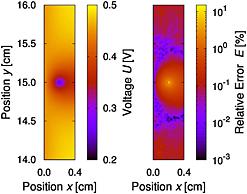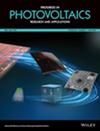Bart E. Pieters, Uwe Rau
下载PDF
{"title":"包含局部缺陷的薄膜太阳能组件电池条电位的二维新模型","authors":"Bart E. Pieters, Uwe Rau","doi":"10.1002/pip.2436","DOIUrl":null,"url":null,"abstract":"<p>The performance of solar modules is strongly influenced by the presence of local defects (shunts) in the module. Modeling cell stripes with local defects requires at least a 2D model. Most works on such 2D models are based on the numerical solution of the involved differential equations. These numerical models are quite computationally intensive and hence tedious for applications that require many evaluations of the model, for example, fitting experiments, computing accurate current/voltage characteristics, and finding a maximum power point. In this work, we present a fast 2D model for a cell stripe based on the superposition of several analytical expressions. This model uses a linearization of the solar cell current/voltage characteristics and takes the sheet resistance of one electrode into account (i.e., the other electrode is assumed to be a perfect conductor). With our model, the potential distribution in a cell stripe in the presence of local shunts can be computed in a matter of seconds. The model has been made freely available. Copyright © 2013 John Wiley & Sons, Ltd.</p>","PeriodicalId":223,"journal":{"name":"Progress in Photovoltaics","volume":"23 3","pages":"331-339"},"PeriodicalIF":7.6000,"publicationDate":"2013-10-26","publicationTypes":"Journal Article","fieldsOfStudy":null,"isOpenAccess":false,"openAccessPdf":"https://sci-hub-pdf.com/10.1002/pip.2436","citationCount":"6","resultStr":"{\"title\":\"A new 2D model for the electrical potential in a cell stripe in thin-film solar modules including local defects\",\"authors\":\"Bart E. Pieters, Uwe Rau\",\"doi\":\"10.1002/pip.2436\",\"DOIUrl\":null,\"url\":null,\"abstract\":\"<p>The performance of solar modules is strongly influenced by the presence of local defects (shunts) in the module. Modeling cell stripes with local defects requires at least a 2D model. Most works on such 2D models are based on the numerical solution of the involved differential equations. These numerical models are quite computationally intensive and hence tedious for applications that require many evaluations of the model, for example, fitting experiments, computing accurate current/voltage characteristics, and finding a maximum power point. In this work, we present a fast 2D model for a cell stripe based on the superposition of several analytical expressions. This model uses a linearization of the solar cell current/voltage characteristics and takes the sheet resistance of one electrode into account (i.e., the other electrode is assumed to be a perfect conductor). With our model, the potential distribution in a cell stripe in the presence of local shunts can be computed in a matter of seconds. The model has been made freely available. Copyright © 2013 John Wiley & Sons, Ltd.</p>\",\"PeriodicalId\":223,\"journal\":{\"name\":\"Progress in Photovoltaics\",\"volume\":\"23 3\",\"pages\":\"331-339\"},\"PeriodicalIF\":7.6000,\"publicationDate\":\"2013-10-26\",\"publicationTypes\":\"Journal Article\",\"fieldsOfStudy\":null,\"isOpenAccess\":false,\"openAccessPdf\":\"https://sci-hub-pdf.com/10.1002/pip.2436\",\"citationCount\":\"6\",\"resultStr\":null,\"platform\":\"Semanticscholar\",\"paperid\":null,\"PeriodicalName\":\"Progress in Photovoltaics\",\"FirstCategoryId\":\"88\",\"ListUrlMain\":\"https://onlinelibrary.wiley.com/doi/10.1002/pip.2436\",\"RegionNum\":2,\"RegionCategory\":\"材料科学\",\"ArticlePicture\":[],\"TitleCN\":null,\"AbstractTextCN\":null,\"PMCID\":null,\"EPubDate\":\"\",\"PubModel\":\"\",\"JCR\":\"Q1\",\"JCRName\":\"ENERGY & FUELS\",\"Score\":null,\"Total\":0}","platform":"Semanticscholar","paperid":null,"PeriodicalName":"Progress in Photovoltaics","FirstCategoryId":"88","ListUrlMain":"https://onlinelibrary.wiley.com/doi/10.1002/pip.2436","RegionNum":2,"RegionCategory":"材料科学","ArticlePicture":[],"TitleCN":null,"AbstractTextCN":null,"PMCID":null,"EPubDate":"","PubModel":"","JCR":"Q1","JCRName":"ENERGY & FUELS","Score":null,"Total":0}
引用次数: 6
引用
批量引用


 求助内容:
求助内容: 应助结果提醒方式:
应助结果提醒方式:


